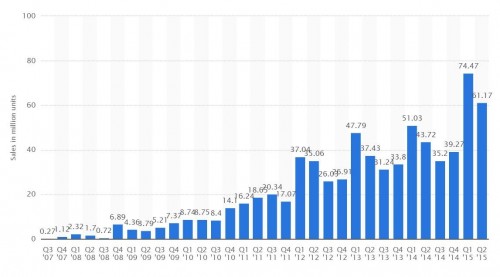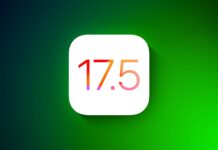The evolution of sales of iPhone terminals from the almost 8 years of the existence of smartphones Apple Lossless Audio CODEC (ALAC), proves to us that the world is more and more interested in premium mobile terminals that have customized functions. If in the first fiscal quarter of the iPhone's existence only 270 thousand units were sold in the US, the figure increased to 1.12 million units in the second fiscal quarter of its existence and to 2.32 million units in the third.
As Apple launched new models, sales increased exponentially, the most radical increase, approximately 10 times from one fiscal quarter to another, recorded in Q4 2008, three months after the appearance of the iPhone 3G. Then Apple seriously expanded the number of partners that sold iPhone terminals, and from that point sales continued to grow fiscal quarter after fiscal quarter.
Despite the evolution, only the appearance of the iPhone 4 in 2010 generated a new "boom" in terms of sales of iPhone terminals, when they increased by almost 100% compared to the previous fiscal quarters. Things evolved until the end of 2011, when Apple recorded a new serious growth of approximately 50% in sales, the end of 2012 bringing a similar positive evolution.
 2013 was a "dead" year for the Apple company, the iPhone 5S managing to keep the line of iPhone terminals on the "right path", but only in 2014 iPhone 6 si 6 iPhone Plus they managed to bring back interest in Apple products. In two fiscal quarters of the existence of these two products, Apple sold 145.64 million iPhone terminals worldwide.
2013 was a "dead" year for the Apple company, the iPhone 5S managing to keep the line of iPhone terminals on the "right path", but only in 2014 iPhone 6 si 6 iPhone Plus they managed to bring back interest in Apple products. In two fiscal quarters of the existence of these two products, Apple sold 145.64 million iPhone terminals worldwide.
If we look at the previous fiscal quarters, the figure represents almost the entire year of sales of the iPhone 5S, so we are talking about an enormous increase registered by Americans. If Apple sold more iPhones in just 6 months than in a whole year with iPhone 5S, then we can expect that the year of existence of iPhone 6 and iPhone 6 Plus will generate an annual sales record for iPhone terminals.















